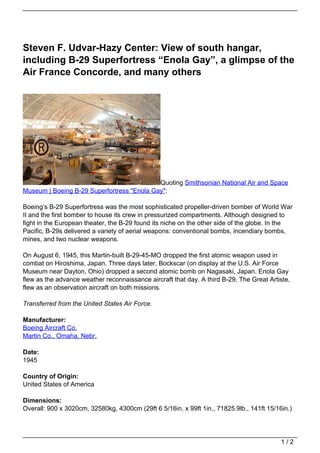Steven F. Udvar-Hazy Center: View of south hangar, including B-29 Superfortress “Enola Gay”, a glimpse of the Air France Concorde, and many others
- 1. Steven F. Udvar-Hazy Center: View of south hangar, including B-29 Superfortress ŌĆ£Enola GayŌĆØ, a glimpse of the Air France Concorde, and many others Quoting Smithsonian National Air and Space Museum | Boeing B-29 Superfortress "Enola Gay": BoeingŌĆÖs B-29 Superfortress was the most sophisticated propeller-driven bomber of World War II and the first bomber to house its crew in pressurized compartments. Although designed to fight in the European theater, the B-29 found its niche on the other side of the globe. In the Pacific, B-29s delivered a variety of aerial weapons: conventional bombs, incendiary bombs, mines, and two nuclear weapons. On August 6, 1945, this Martin-built B-29-45-MO dropped the first atomic weapon used in combat on Hiroshima, Japan. Three days later, Bockscar (on display at the U.S. Air Force Museum near Dayton, Ohio) dropped a second atomic bomb on Nagasaki, Japan. Enola Gay flew as the advance weather reconnaissance aircraft that day. A third B-29, The Great Artiste, flew as an observation aircraft on both missions. Transferred from the United States Air Force. Manufacturer: Boeing Aircraft Co. Martin Co., Omaha, Nebr. Date: 1945 Country of Origin: United States of America Dimensions: Overall: 900 x 3020cm, 32580kg, 4300cm (29ft 6 5/16in. x 99ft 1in., 71825.9lb., 141ft 15/16in.) 1/2
- 2. Materials: Polished overall aluminum finish Physical Description: Four-engine heavy bomber with semi-monoqoque fuselage and high-aspect ratio wings. Polished aluminum finish overall, standard late-World War II Army Air Forces insignia on wings and aft fuselage and serial number on vertical fin; 509th Composite Group markings painted in black; "Enola Gay" in black, block letters on lower left nose. Blog this! Bookmark on Delicious Digg this post Recommend on Facebook Share on FriendFeed Buzz it up Share on Linkedin Share via MySpace Share on Orkut Share on Posterous share via Reddit Share with Stumblers Share on technorati Tumblr it Tweet about it Buzz it up Subscribe to the comments on this post 2/2 Powered by TCPDF (www.tcpdf.org)


